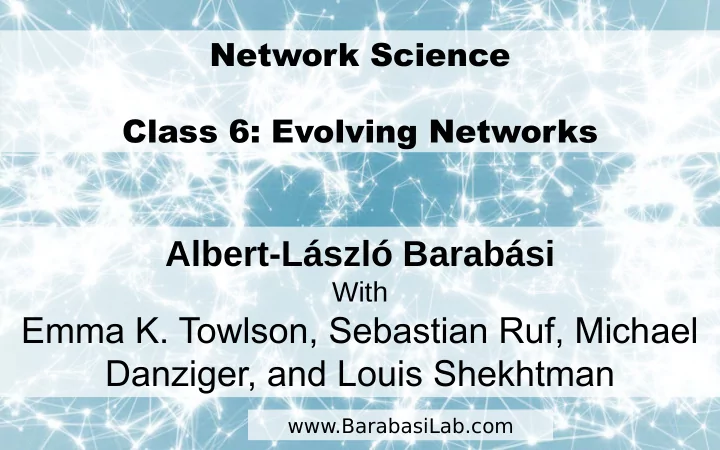

Network Science Class 6: Evolving Networks Albert-László Barabási With Emma K. Towlson, Sebastian Ruf, Michael Danziger, and Louis Shekhtman www.BarabasiLab.com
Section 6.4 Bose-Einstein condensation
MAPPING TO A QUANTUM GAS h k i i Network Bose gas i h k j j j - b h e ( h ( k ) n ) in r ( h ( ) g ) Fitness η Energy level ε New node with fitness η New energy level ε Link pointing to node η Particle at level ε Network quantum gas G. Bianconi and A.-L. Barabási, Physical Review Letters 2001; cond-mat/0011029 Network Science: Evolving Network Models
BOSE-EINSTEIN CONDENSATION e - b i k i (t, t i , i ) ¶ k i (t, t i , i ) m . å e - b j k j (t, t j , j ) ¶ t j f ( ) i t f( )=e -b(-m) . k ( t , t , ) m i i t i The dynamic exponent f(e) depends on m, determined by the self-consistent equation: ò ò 1 1 d g ( ) n ( ) b m I ( , ) d p ( ) 1 . b - m - ( ) e 1 1 n ( ) b - m - ( ) e 1 Network Science: Evolving Network Models
Section 4 Bose-Einstein Condensation
Section 4 Bose-Einstein Condensation
Bose-Einstein Condensation Bianconi & Barabási, Physical Review Letters 2001; Europhys. Lett. 2001. Network Science: Evolving Network Models
FITNESS MODEL: Bose-Einstein Condensation Bianconi & Barabási, Physical Review Letters 2001; Europhys. Lett. 2001.
Section 6.5 Evolving Networks
Section 6.5 Limitations
Section 5 INITIAL ATTRACTIVENESS Increases the degree exponent. Generates a small-degree cutoff.
Section 5 INTERNAL LINKS Π( k ,k ' )∼( A + Bk )( A + Bk ' ) Double preferential attachment (A=0). Random attachment (B=0).
Section 5 NODE DELETION r < 1 : Scale-free phase • Start with the Barabási-Albert model. • In each time step: r = 1 : Exponential phase • add a new node with m links • remove r nodes (in average). r > 1: Declining network
Section 5 NODE DELETION • Start with the Initial Attractiveness model: • In each time step: • add a new node with m links • remove r nodes (in average).
Section 5 The Impossibility of Node deletion Jan Hendrik Schỏn
Section 5 Declining Fashion: New York
Section 5 Declining Fashion
Section 5 Accelerated growth we assumed that L = k N, where k is ⟨ ⟩ ⟨ ⟩ independent of time or N. • the average degree of the Internet increased from 3.42 (Nov. 1997) to 3.96 (Dec. 1998); • the WWW increased its average degree from 7.22 to 7.86 during five months; • in metabolic networks the average degree of the metabolites grows approximately linearly with the number of metabolites [33].
Section 5 Aging ν<0: new nodes attach to older nodes enhances the role of preferential attachment. ν→ −∞ each new node will only connect to the oldest node hub-and-spoke topology (Fig 6.10a). ν>0: new nodes attach to younger nodes ν→ +∞: each node will connect to its immediate predecessor (Fig. 6.10a).
Section 5
Section 5 Summary
Section 6 summary : Topological Diversity SECTION 4.11
Section 6 summary : Topological Diversity
Section 6 summary : Topological Diversity
Section 6 summary
LESSONS LEARNED: evolving network models 1. There is no universal exponent characterizing all networks. 2. Growth and preferential attachment are responsible for the emergence of the scale-free property. 3. The origins of the preferential attachment are system-dependent. 4. Modeling real networks: identify the low-level processes in the system • measure their frequency from real data • develop dynamical models to capture these processes. • 5. If the model is correct, it should correctly predict not only the degree exponent, but both small and large k-cutoffs. Network Science: Evolving Network Models
The end Network Science: Evolving Network Models
Recommend
More recommend